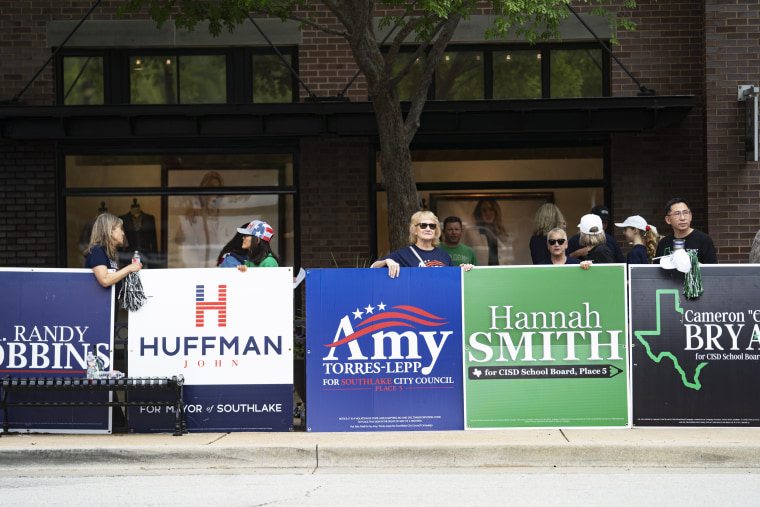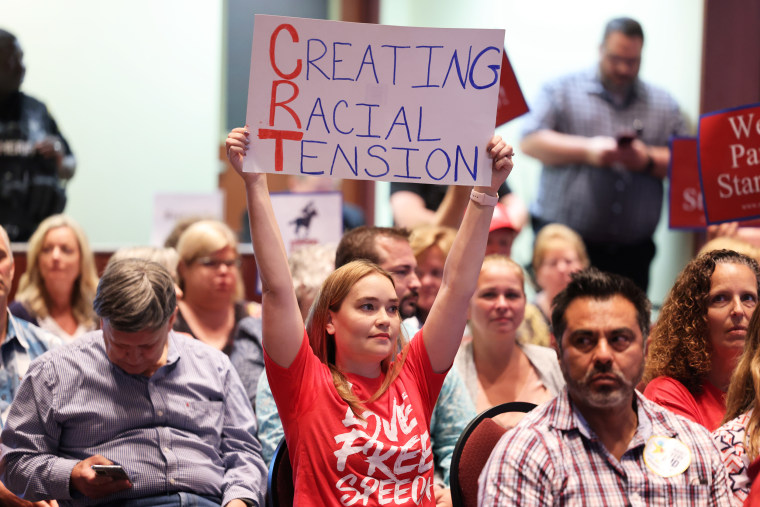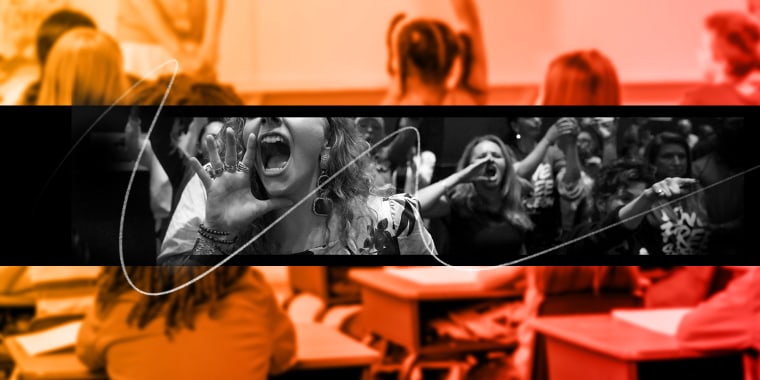Downingtown, Pennsylvania, a suburb of Philadelphia, has been changing. And the school district has tried to change with it.
In 1994, students of color made up just 5 percent of the enrollment in the Downingtown Area School District. By 2020, that figure had grown to almost 24 percent, largely because of an increase in Asian and Latino residents.
In the last few years, the district hired a diversity coordinator, launched a cultural equity task force and began to study racial disparities in how students are placed in advanced classes. The district made Diwali an official school holiday this year, and in the spring held a listening session for people of Asian descent to discuss racism they had experienced.
But all of these measures suddenly came under attack this summer, when dozens of parents signed a petition calling for the end of Downingtown’s diversity, equity and inclusion initiatives. Parents and local Republican groups questioned why Downingtown schools needed a diversity coordinator at all, citing the schools’ high graduation rates and the lack of high-profile hate crimes in the community. Several parents labeled the diversity efforts “social engineering” and racist at school board meetings.
Downingtown is one of at least 220 school districts in the U.S. that faced a backlash over diversity and equity initiatives from May through August, according to NBC News’ tracking of media reports. And student enrollment data suggests that these conflicts tend to occur in communities that experienced significant demographic shifts in recent decades.
An NBC News analysis of 33 cities and counties where school districts have faced rancor over equity initiatives this year in at least three recent school board meetings finds that each has become less white over the last 25 years, reflecting a national trend.
To explore whether something unusual was happening in those 33 districts, the analysis focused on a metric known as exposure, which measures how likely white students are to have classmates of a different race — not just in their district overall, but in their school. While students of color have become a larger share of public school students nationally, accounting for 54 percent of total student enrollment in 2020, communities have long segregated their schools to cluster students of color together. The exposure measurement goes deeper by examining how much schools have diversified.
The analysis, using federal statistics, found that the exposure of white students to students of color increased by 11 percentage points across the United States from 1994 to 2020. And in 22 of the 33 districts facing recent battles over diversity initiatives, the exposure of white students to students of color increased more than that national average.
“We know Gen Z is more diverse than any generation in American history, and I think those changes are being felt,” said Brandyn Campbell, a Black mother in Downingtown, who works as an equity consultant for companies. “Folks like me welcome it, and there are a lot of folks who do not feel that way — I think they feel very threatened.”
In Downingtown, the share of students of color in the average white child’s school grew by 17 percentage points from 1994 to 2020. In Southlake, Texas, where school board candidates successfully ran on a platform opposing a diversity plan, the share of students of color in the average white child's school increased by 29 percentage points over the same period. And in Loudoun and Fairfax counties, Virginia suburbs of Washington where complaints about diversity efforts have fueled campaigns by parents to recall school board members, the increase was 30 and 24 percentage points, respectively.
“In virtually any community, when there is rapid demographic change you see a backlash,” said Tomás Jiménez, a Stanford University professor who has studied population changes in cities. The conflict often manifests around things that reflect the shift, such as celebrating different holidays or signs in different languages, he said. “When demographic change happens quickly, the backlash tends to be stronger.”
These fraught debates over how to talk about race with the next generation come as the nation’s white majority continues to shrink, according to new census figures. The local objections to diversity programs in schools have also been reinforced by a loose network of conservative think tanks and organizations run by former Trump administration officials, and amplified in conservative media, fueled by Republicans who see an opportunity to mobilize their base.

Yet, schools say the population changes that may provoke anxiety in some are also precisely why they must make equity and inclusion initiatives a priority.
“Many of the families that live in Downingtown went to Downingtown schools,” said Jennifer Shealy, the communications director for the district, who is white. “And when they did, we were a less diverse school district, and now that has changed significantly. Some of the people who are questioning this don’t recognize the problem. You learn better if you’re more comfortable. If you’re living in fear or feel like you’re bullied, it’s much more difficult to learn.”
'Our children don't do that'
At a July school board meeting, several Downingtown parents said the district’s focus on race and diversity stoked division among children. One woman said that “none of them see race, none of them see color, OK? Our children don't do that.” Another woman told the board, “Emphasis and hyper-focus on race will only divide us.”
Neither speaker responded to a request for comment.
Several parents and students spoke at the same meeting in support of the district’s diversity, equity and inclusion program, including Lakshmi Iyer, who was born in India and moved to Downingtown in 2001. She described her children’s experiences in elementary school to make the case that the inclusion efforts are imperative.
A child once told one of her three daughters that she had to be a servant while playing make-believe because she had brown skin, Iyer said, and another time, classmates mistook her other two daughters for Mexican and told them they had to leave the country. Iyer credited the district with taking steps in recent years to make her family feel more welcome. But the backlash in recent weeks to those efforts shocked her.
“This past month is when my innocence has been shattered,” Iyer said in an interview. “I really thought we lived in an inclusive community.”
The onslaught of activism caught many public school systems by surprise. Administrators scrambled to explain why they were focused on combating racial bias. In Downingtown, the district’s new diversity coordinator gave lengthy presentations at two school board meetings in August laying out why administrators started focusing on equity, pointing to the changing racial composition of the student body, but conceding that the district had not publicized some of this work until recently.
Research has linked increased racial diversity within a school, as well as an emphasis on equity and inclusion, with improved academic outcomes. When students have more interaction with classmates of different ethnic backgrounds, and view the racial climate on campus as positive, research has also shown they’re more likely to have friendships across group lines and to have more confidence in their own academic abilities.
But school districts should explain why they’re focused on diversity “sooner rather than later,” before the backlash begins, said Keffrelyn Brown, a professor and co-founder of the Center for Innovation in Race, Teaching, and Curriculum at the University of Texas at Austin.
“If you really want to have unity and a sort of strong community that works together, you can’t do that by erasing difference, because to erase difference is to erase who people are,” she said. “You can’t ask people to give up who they are. We have to find ways to talk to one another.”
Because younger generations are more diverse, “schools are almost always going to be on the leading edge of demographic change in a community,” said Erica Frankenberg, an education policy professor at Penn State University.
Public schools are also one of the few institutions where residents of a town come together, whether at school dropoff or Friday night football games. And since public schools are an arm of the government, residents feel entitled to have an opinion, said Van C. Tran, an immigration scholar and urban sociologist at The Graduate Center of the City University of New York.
“You can’t walk into Goldman Sachs and JP Morgan and protest a lack of diversity because it’s a private entity, no one has to listen to me,” Tran said. “However, the public school system is seen as the beacon of hope, of equal opportunity for all children, which is why this debate is so heated at the local level.”
Eager to do something
Multiple school districts within Chester County, Pennsylvania, where Downingtown is, have faced a similar backlash to diversity, equity and inclusion efforts. It began after a political shift.
Democrats won elections in Chester County last year that had historically been Republican seats. Local GOP groups have latched onto curriculum debates in local school districts and promoted school board candidates who promise to “keep politics out of our schools.” A national political group run by former Trump adviser Stephen Miller recently filed a records request demanding all documents related to diversity, equity and inclusion programming in the county’s Tredyffrin-Easttown School District. Miller labeled his group’s involvement an effort “to protect America’s kids from this racist indoctrination.”
Rick Hess, lead education scholar at the American Enterprise Institute, a conservative-leaning think tank, said it’s the “silliest thing in the world” to suggest that anxiety over changing demographics is driving the backlash to diversity programs in schools. As proof that the country is accepting racial and demographic change, he cited growth in interracial marriages and Barack Obama’s election and re-election.
Instead, he said, a lot of the parental concern is rooted in objections to the way schools are going about this diversity work, including opposition to race-conscious practices and the way some schools are defining and combating examples of white supremacy in teacher training materials.
“Schools have been so eager to do something that they haven't thought very carefully about what they're doing,” Hess said.
The Rev. Kyle J. Boyer, a school board member in the Tredyffrin-Easttown district, said if people expect schools to prepare children for an increasingly diversified workforce, then educators have “an essential role to play in preparing this citizenry to value equity and inclusion.”
“Talking about race is not racism, and you hear that a lot — it makes you cringe,” said Boyer, who is Black and a public school math teacher. “There’s no way to deal with something that is a flash point unless you deal with it. The answer to something that causes difficulty is not to ignore and not address it — the answer is to learn how to properly engage it.”
Critical race theory battles bleed into campaigns
In Gwinnett County, Georgia, an Atlanta suburb where the share of students of color in the average white pupil’s school has jumped by 52 percentage points since 1994, that growing diversity has also been reflected in the school leadership. Three of the five members on the school board are now people of color, according to The Atlanta Journal-Constitution, including two who beat white incumbents in last year’s election. In July, the board hired the district’s first Black superintendent.
Throughout the year, parents filled Gwinnett County School Board meetings to voice objections to what they described as critical race theory, which the district has said it does not teach. Critical race theory is a legal framework to examine how racism is embedded in laws and institutions, but conservative activists have co-opted the term to describe discussions of race and gender they believe are too progressive.

In Virginia, Republican candidates campaigning on promises to ban critical race theory have pointed to Loudoun County as the center of a fight against “anti-American indoctrination in K-12 schools.” The county has swung from a GOP stronghold to reliably Democratic over the past two decades as its population swelled.
The share of students of color in the average white child's school in the county has increased by 30 percentage points since 1994, and the school district launched a series of racial equity initiatives after the Virginia attorney general’s office found students of color had faced ongoing racial discrimination. In response, parents packed school board meetings, where they insisted that books and lessons offered to students that dealt with race were too ideological, and started an effort to recall Democrats on the school board.
Jiménez, of Stanford, said conflicts that emerge in a moment of abrupt change tend to die down when people become more accustomed to the new demographics. As children spend time together with classmates of different backgrounds in schools, on athletic teams and at each other’s birthday parties, he said, that often forces parents to interact more with people who they might not otherwise talk to. The parents might not become best friends, but they start to develop a sense of familiarity, he said.
“We tend in the moment to assume whatever the state of affairs is right now is how it will be going forward, and that's not the case,” he said. “Most people are going about their lives and I do think over time and across generations, these things tend to be baked into everyday life.”




